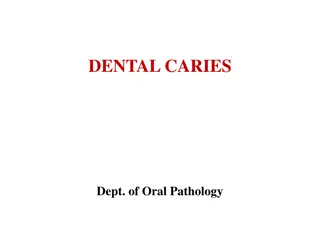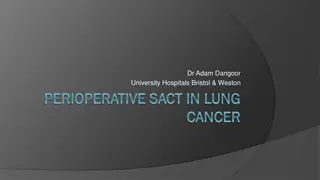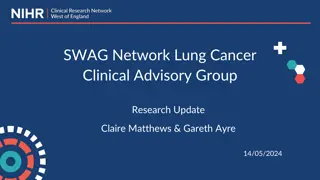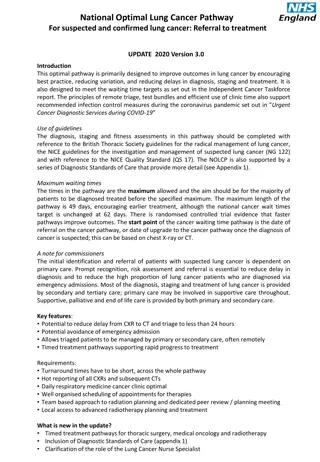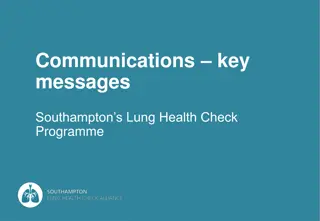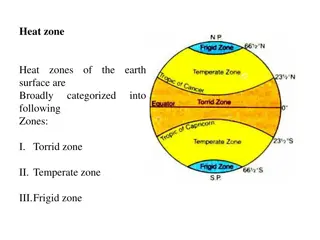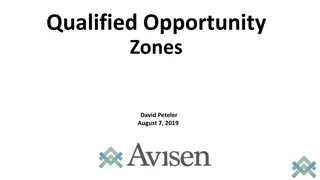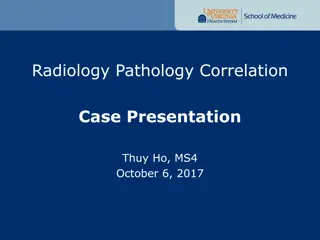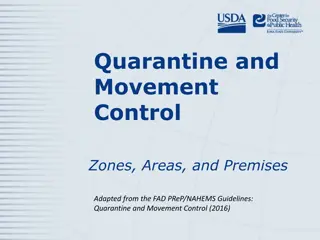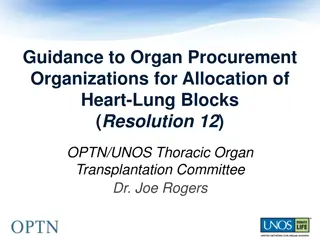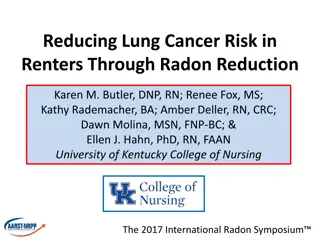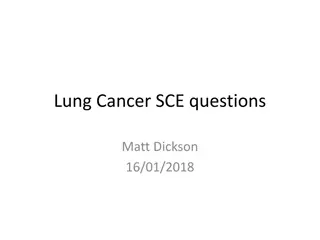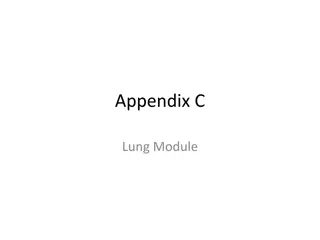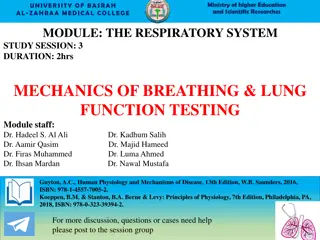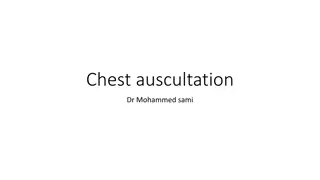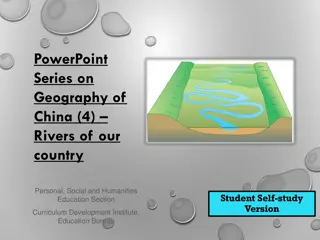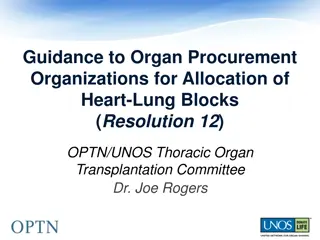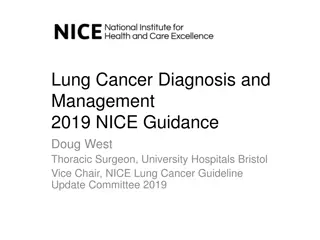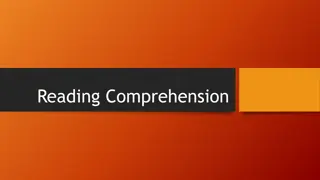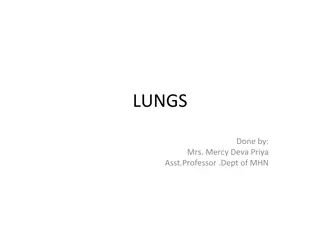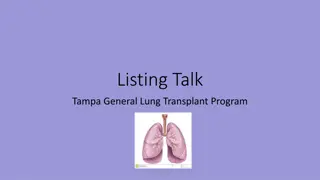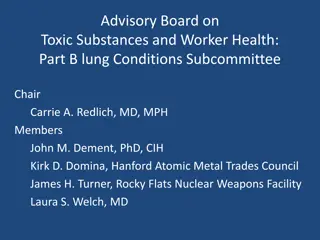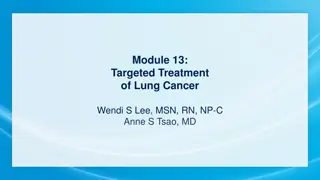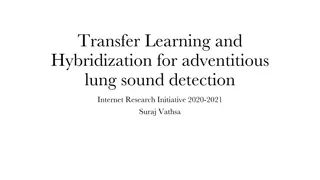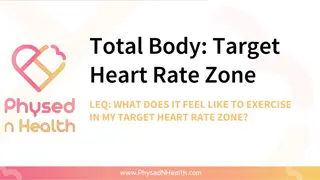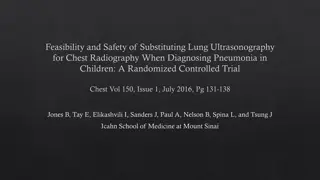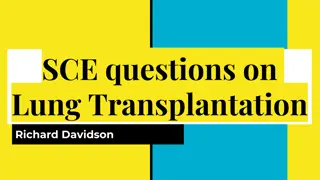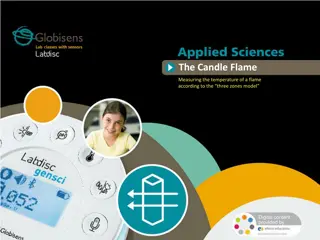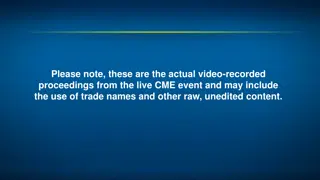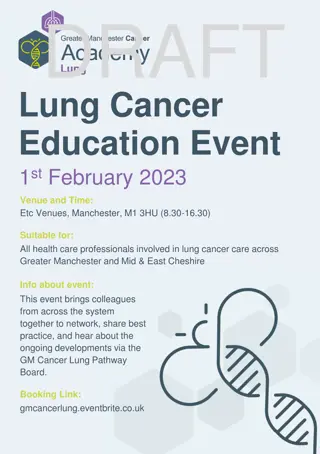Understanding Lung Cancer Screening Programs and Criteria
Screening for lung cancer is essential for early detection and intervention. CT scans have shown promise in reducing mortality rates, especially in high-risk populations. While challenges like cost and radiation risk exist, initiatives like the National Lung Screening Trial have demonstrated the eff
4 views • 28 slides
Understanding Enamel Caries: Zones and Histopathology
Enamel caries is examined through histopathology, revealing four distinct zones - Translucent, Dark, Body, and Unaffected. Each zone presents unique characteristics, such as pore formation and light absorption. Understanding these zones is crucial for identifying and describing enamel caries accurat
1 views • 16 slides
Advances in Perioperative Treatment of Lung Cancer: A Comprehensive Review
Explore the evolution of perioperative treatment for lung cancer from historical perspectives to current advancements. Learn about the efficacy of different chemotherapy agents, immunotherapies, and adjuvant treatments, along with the impact on patient outcomes and resectability criteria. Discover t
1 views • 19 slides
Latest Research and Studies on Lung Cancer - Update May 2024
This research update includes information on national recruitment to lung cancer studies, comparison of national vs. regional recruitment, and detailed descriptions of various studies and trials related to lung cancer. The studies cover areas such as treatment advancements, observational studies, ma
2 views • 13 slides
Comprehensive Overview of Pulmonary Function Tests (PFTs)
Pulmonary Function Tests (PFTs) are vital for assessing pulmonary gas exchange through ventilation, diffusion, and lung perfusion. These tests include measurements of lung volume, airway patency, gas exchange efficacy, and pulmonary blood flow. PFTs offer benefits in diagnosing dyspnea, monitoring d
0 views • 14 slides
National Optimal Lung Cancer Pathway: Referral to Treatment Update 2020 Version 3.0
This optimal pathway aims to improve outcomes in lung cancer by reducing delays in diagnosis, staging, and treatment, while meeting waiting time targets. It emphasizes remote triage, test bundles, and efficient clinic use. The pathway includes maximum waiting times, timely treatment pathways, and gu
0 views • 16 slides
Southampton Lung Health Check Programme Overview
Southampton is part of a national Lung Health Check programme offering free lung MOT tests to smokers and former smokers aged 55-74. Specially trained nurses conduct checks in mobile vans around the city, aiming to detect lung problems early. Eligible individuals will receive invitation letters from
0 views • 10 slides
Earth's Heat Zones and Celestial Events Explained
Heat zones of the earth surface are categorized into Torrid, Temperate, and Frigid zones. The Torrid Zone lies between the Tropic of Cancer and the Tropic of Capricorn, experiencing the most direct sunlight. The Temperate Zones have milder climates and are situated between the Arctic and Antarctic C
0 views • 7 slides
Transforming Lung Cancer Care in South West: Cancer Alliance Priorities
Cancer Alliances play a crucial role in coordinating cancer care and improving outcomes for patients. The South West Lung Pathway Transformation focuses on implementing rapid assessment pathways for lung, prostate, and colorectal cancers. Their priorities include meeting waiting time standards, diag
0 views • 23 slides
Understanding Qualified Opportunity Zones Tax Benefits
Qualified Opportunity Zones (Opportunity Zones) offer tax incentives to investors who reinvest capital gains in designated low-income communities. By utilizing Qualified Opportunity Funds (QOF), investors can benefit from capital gains deferral, partial gain exclusion, and full gain exclusion on app
0 views • 12 slides
Radiology-Pathology Correlation Case Presentation: Ms. DR - Lung Mass Evaluation
Ms. DR, a 62-year-old female with a history of tobacco use, presents with a right lung mass and possible metastatic disease. Imaging reveals a FDG-avid lung mass suspicious for primary malignancy. After obtaining informed consent, a CT-guided core biopsy is performed, showing cohesive, medium-sized
1 views • 16 slides
Subdivision Analysis for Load Zones Optimization
This project aims to subdivide existing load zones to enhance aggregations and SCED clearing processes. Criteria for subdivision, determining the number of new zones, and clustering based on pricing are addressed. A study will be conducted to subdivide existing zones into 3, 4, and 5 new zones, clus
0 views • 6 slides
Guidelines for Quarantine and Movement Control Zones and Premises
This presentation outlines the designation of zones, areas, and premises as per the FAD PReP/NAHEMS guidelines for quarantine and movement control. It covers the establishment of control areas, minimum sizes of zones, and premises designations including infected, contact, suspect, and at-risk premis
0 views • 16 slides
Enhancing Heart-Lung Allocation Policy for Organ Transplantation
This project focuses on improving the allocation of heart-lung blocks for organ transplantation by providing clear guidelines to Organ Procurement Organizations (OPOs). The goal is to ensure consistent practices among OPOs across the country, promoting fairness and efficiency in organ allocation. Th
0 views • 11 slides
Addressing Lung Cancer Risk in Renters: Strategies for Radon Reduction
Lung cancer risk in renters due to radon exposure is a significant concern, especially for those in lower-income brackets. This article sheds light on the synergistic risks of radon and tobacco smoke, emphasizing the importance of reducing radon levels in rental properties to safeguard the health of
0 views • 24 slides
Lung Cancer Questions and Answers
This set of questions covers various aspects of lung cancer, including statistics, TNM staging, non-small cell lung cancers, and small cell lung cancers. Each question presents multiple choices, testing the reader's knowledge on different topics related to lung cancer.
0 views • 9 slides
Comprehensive IGRT Lung Module for Radiation Therapy Education
Improve your understanding of Image-Guided Radiation Therapy (IGRT) with this comprehensive lung module. Discover the importance of accurate targeting for lung cancer treatment, learn about cross-sectional anatomy, explore regions of interest, and understand machine parameters for Varian and Elekta
0 views • 32 slides
Export Marketing and Promotion Organizations in India
Government of India has established various export marketing and promotion organizations since 1951 to assist the export sector. These organizations play a crucial role in promoting and diversifying India's exports by providing services such as advisory functions, information collection, trade deleg
0 views • 9 slides
Understanding Mechanics of Breathing in the Respiratory System
Explore the mechanics of breathing in the respiratory system, including pressure variations in inspiration and expiration, effects of introducing air into the pleural space, consequences of lung stiffness or compliance changes, conditions affecting lung stretchability, impact of small airway narrowi
0 views • 21 slides
Understanding Lung Sounds and Auscultation Techniques
Exploring the world of chest auscultation with Dr. Mohammed Sami, this guide provides insights into how to listen to lung sounds, where to listen, what to listen for, and the use of a stethoscope. Learn about different lung areas, sound characteristics, airflow patterns, and the mechanics behind bre
0 views • 34 slides
Distribution Pattern of River Zones in China
China has a vast network of rivers with different characteristics and distribution patterns. The country is divided into five zones based on factors like precipitation and runoff levels, ranging from abundant to deficit zones. These zones play a crucial role in understanding the water resources and
0 views • 14 slides
Overview of Respiratory System Components and Functions
The respiratory system consists of vital components like pulmonary compliance and surfactant, crucial for proper lung function. Pulmonary compliance reflects the lung's ease of expansion, influenced by factors like lung elasticity and surface tension. Surfactant, produced by type II alveolar cells,
0 views • 15 slides
Pulmonary Abnormalities and Their Physiologic Effects
Chronic pulmonary emphysema is a complex obstructive and destructive lung condition typically caused by smoking. It leads to chronic infection, excessive mucus production, airway obstruction, and lung tissue destruction. The physiological effects of emphysema include hypoxia, hypercapnia, and severe
0 views • 12 slides
Optimization of Heart-Lung Allocation Policy for Organ Procurement Organizations (OPOs)
This document provides guidance to Organ Procurement Organizations (OPOs) regarding the allocation of heart-lung blocks, focusing on resolving issues related to Policy 6.5.E. The aim is to establish clear policies and principles to ensure consistent allocation practices among OPOs nationwide. Throug
0 views • 11 slides
Comprehensive Update on Lung Cancer Diagnosis and Management According to 2019 NICE Guidelines
Providing a detailed overview of the 2019 NICE guidance on lung cancer, this content covers various aspects including the role of NICE, types of guidance provided, updates on lung cancer surgery, recommendations on tobacco addiction interventions, diagnostic approaches, and new protocols for brain i
0 views • 35 slides
Innovative Technology for Diagnosing and Managing Respiratory Diseases
Monash University researchers have developed a groundbreaking non-invasive technology to diagnose and manage respiratory lung diseases, such as cystic fibrosis and lung cancer. The technology, utilizing four-dimensional X-ray velocity imaging, provides high-definition real-time images of airflow in
0 views • 4 slides
Understanding the Anatomy of Lungs
The lungs, vital organs of the respiratory system, consist of two cone-shaped structures with apex, base, costal, and medial surfaces. Positioned in the thoracic cavity, they are associated with the heart, great vessels, and other structures in the mediastinum. The right lung has three lobes, while
0 views • 16 slides
Tampa General Lung Transplant Program Information Update
The Tampa General Lung Transplant Program aims to extend the lives of patients with irreversible lung diseases through timely transplants. The program emphasizes commitment to long-term health management, with a dedicated team of medical professionals providing comprehensive care. Patients are guide
0 views • 27 slides
Progress Report of Part B Lung Conditions Subcommittee
Progress report detailing the activities of the Part B Lung Conditions Subcommittee from initial advisory board meetings to defining data needs, reviewing data analysis, and addressing questions and comments from the Department of Labor related to lung conditions including Chronic Beryllium Disease
0 views • 18 slides
Targeted Treatment Options for Lung Cancer Patients
Explore targeted treatment approaches for lung cancer through real-life patient cases, expert insights, and updates on therapies. Learn about personalized care, innovative options, and advancements in non-small cell lung cancer treatment. Delve into disclosures from healthcare professionals involved
0 views • 49 slides
Advanced Artificial Intelligence for Adventitious Lung Sound Detection
This research initiative by Suraj Vathsa focuses on using transfer learning and hybridization techniques to detect adventitious lung sounds such as wheezes and crackles from patient lung sound recordings. By developing an AI system that combines deep learning models and generative modeling for data
0 views • 6 slides
Inhibition of TNKS for Lung Cancer Growth Reduction
This study proposes inhibiting TNKS1 and TNKS2 as a potential strategy to reduce lung cancer proliferation. The research explores the impact of pharmacological or genetic inhibition of TNKS on lung cancer growth. It emphasizes the need for new approaches in treating or preventing lung cancer. The fi
0 views • 16 slides
Understanding Target Heart Rate Zones for Optimal Exercise Benefits
Exploring the concept of target heart rate zones for effective exercise routines, this resource delves into different training zones based on age and intensity levels. It explains how to exercise within your target heart rate zone to achieve specific fitness goals like building endurance, improving
0 views • 9 slides
Utility of Lung Ultrasonography in Pediatric Pneumonia Diagnosis
Pneumonia, a leading cause of pediatric mortality globally, presents diagnostic challenges as history and physical exams may not reliably differentiate viral lung infections from bacterial pneumonia. This study explores the feasibility and safety of substituting lung ultrasonography (LUS) for chest
0 views • 21 slides
Insights into Lung Transplantation: Causes of Death and Survival Rates
Explore the common causes of death in lung transplant recipients, including malignancy, graft failure, and infections. Understand the relative incidence of leading causes of death in adult lung transplant recipients over different time periods. Learn about survival rates following lung transplantati
0 views • 40 slides
Understanding Trip Rates and Balancing Productions and Attractions in Urban Planning
Trips generated at household ends are categorized as productions and are attracted to various zones for activities like work, shopping, social visits, and medical trips. Urban planners determine trip generation rates to estimate the number of trips attracted to specific zones. This process involves
0 views • 6 slides
Understanding Candle Flame Temperature through Color Zones Model
Explore the correlation between temperature and color in a candle flame using the three zones model. Learn how the different zones of a candle flame represent varying temperatures, from the blue basal region to the orange/brown incomplete combustion area. Conduct experiments to measure these tempera
0 views • 21 slides
Clinical Investigator Perspectives on Lung Cancer Management: Live CME Event
Clinical investigators including D. Ross Camidge, Stephen V. Liu, Solange Peters, Gregory J. Riely, and David R. Spigel share their insights on lung cancer management at a live CME event in Chicago. The moderator, Neil Love, discloses ties with various commercial interests for educational grants. Th
0 views • 9 slides
Lung Cancer Education Event - Greater Manchester 2023
The Lung Cancer Education Event in Greater Manchester on February 1, 2023, is designed for all healthcare professionals involved in lung cancer care. The agenda includes sessions on optimizing outcomes post-Covid-19, evolving treatments, essential updates in lung cancer, and thoracic oncology. Join
1 views • 4 slides
Opportunity Zones in Rural Indiana: Driving Investments in High-Need Communities
The presentation discusses the Opportunity Zones program in rural Indiana aimed at boosting investments in underserved communities. It covers the purpose of Opportunity Zones, how they originated, their selection process in Indiana, the program's mechanics, potential investment areas, the New Rural
0 views • 33 slides

